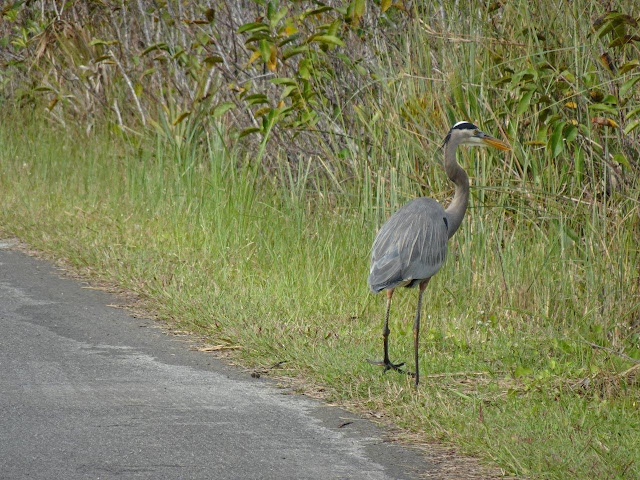I had not been to Sanibel Island and the Ding Darling Wildlife Preserve for several years, so I chose today to go there. It was a cool, but sunny day, so I knew I would not bake or freeze while riding my bike.
If you remember, Sanibel Island was almost completely destroyed in September 2022 by Hurricane Ivan. The only access to the island, the bridge, was inaccessible for a month because the causeway where the bridge stands was cut in a couple of places, as shown here: https://www.npr.org/2022/09/30/1126204141/sanibel-causeway-hurricane-ian Most people had evacuated, but those who stayed had to be ferried off, and many homes, nearly all cars, and most businesses were destroyed. It has been 18 months, and there is still a lot of construction going on, but from what I saw driving in and out, at least 50-60% of businesses were still not open.
Here are some photos of the entrance to the bridge and some of the construction still happening on the causeway to rebuild some beaches and fishing areas:
Eventually, you will be able to pull off the roadway and enjoy the picnic, fishing, and swimming areas again.
Notice the damage to trees. Normally, there would be taller trees and more of them.
In any case, I always enjoy riding my bike and seeing birds at Ding Darling. The preserve consists of several areas of wetlands and large tidal ponds and cypress forests where birds congregate.
This is a good map of the area. I rode around the entire paved roadway, for a total of 9 miles. Not bad for an old lady!
They have a very nice visitor center, and I treated myself to a t-shirt and a tea towel with birds on it!
As you can see, some areas of the parking lot and the grounds near the visitor center are still being worked on.
This is the beginning of the 4.5 mile roadway that goes through the refuge. It is one-way, so you exit at the far end and either drive back on the main road or ride your bike on the path along it. I was surprised by the bare and broken trees.
Looks pretty sad. These are dead trees, not trees that have just lost their leaves for the winter.
This is the first time I have seen a reddish heron. It looks a lot like a great blue heron, but it has a reddish neck.
And a little blue heron, identified by its black and grey beak and small body size.
A flock of American white pelicans resting on a sandbar.
More dead trees. At least the birds are still nesting in some of them.
This is a juvenile white ibis.
And some of his/her siblings on a nearby branch! These birds are extremely common in Florida and can often be found anywhere there is water.
Don't know if you have ever seen one of these, but it is a container to put broken fishing line, hooks, and lures in so birds do not get caught up in them.
And last, but not least, is a yellow-crowned night heron. Normally, you would be able to see his long neck, but a lot of birds scrunch their long necks down when they rest. You can see part of his long legs under the branch in front of him.
The only big problem with visiting Sanibel Island, both now and in the past, is the lack of a second exit. Late the the day, you can wait up to an hour or more to get off the island. It was worse before the hurricane destroyed a lot of restaurants, but just be aware that you should try to leave before 3:00 pm or wait until after the late afternoon rush hour. I left the refuge at 4 pm and it took me over an hour of stop and go traffic to drive the last 3.7 miles to the bridge. Once you get on the bridge, you are usually pretty clear.



























































